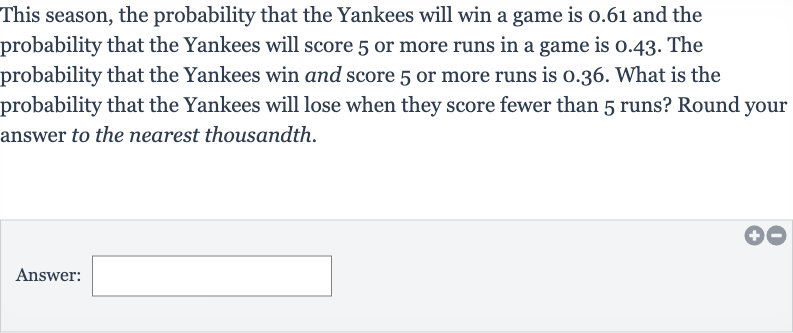AI tutor
Welcome to Bytelearn!
Let’s check out your problem:

This season, the probability that the Yankees will win a game is . and the probability that the Yankees will score or more runs in a game is . . The probability that the Yankees win and score or more runs is . . What is the probability that the Yankees will lose when they score fewer than runs? Round your answer to the nearest thousandth.Answer:
Full solution
Q. This season, the probability that the Yankees will win a game is . and the probability that the Yankees will score or more runs in a game is . . The probability that the Yankees win and score or more runs is . . What is the probability that the Yankees will lose when they score fewer than runs? Round your answer to the nearest thousandth.Answer:
- Denote Events: Let's denote the events as follows:W: The Yankees win a game.S: The Yankees score or more runs in a game.We are given the following probabilities:We want to find the probability that the Yankees lose and score fewer than runs. Let's denote this event as L (Yankees lose) and F (Yankees score fewer than runs).First, we need to find the probability that the Yankees lose a game, which is the complement of the probability that they win. We can calculate this using the formula:
- Calculate Probability of Losing: Now, let's calculate the probability that the Yankees lose a game:
- Calculate Probability of Scoring Fewer Runs: Next, we need to find the probability that the Yankees score fewer than runs. This is the complement of the probability that they score or more runs. We can calculate this using the formula:
- Calculate Probability of Losing and Scoring Fewer Runs: Now, let's calculate the probability that the Yankees score fewer than runs:
- Round Final Answer: To find the probability that the Yankees lose and score fewer than runs, we need to use the Multiplication Rule of Probability for independent events. However, we must first ensure that the events and are independent. Since we are not given any information about their dependence, we will assume they are independent for this calculation. The formula is:
- Round Final Answer: To find the probability that the Yankees lose and score fewer than runs, we need to use the Multiplication Rule of Probability for independent events. However, we must first ensure that the events and are independent. Since we are not given any information about their dependence, we will assume they are independent for this calculation. The formula is:Now, let's calculate the probability that the Yankees lose and score fewer than runs:
- Round Final Answer: To find the probability that the Yankees lose and score fewer than runs, we need to use the Multiplication Rule of Probability for independent events. However, we must first ensure that the events and are independent. Since we are not given any information about their dependence, we will assume they are independent for this calculation. The formula is:Now, let's calculate the probability that the Yankees lose and score fewer than runs:Finally, we round the answer to the nearest thousandth as requested:
More problems from Find probabilities using the addition rule
QuestionGet tutor help
QuestionGet tutor help
QuestionGet tutor help
QuestionGet tutor help
QuestionGet tutor help
QuestionGet tutor help
QuestionGet tutor help
QuestionGet tutor help
QuestionGet tutor help
